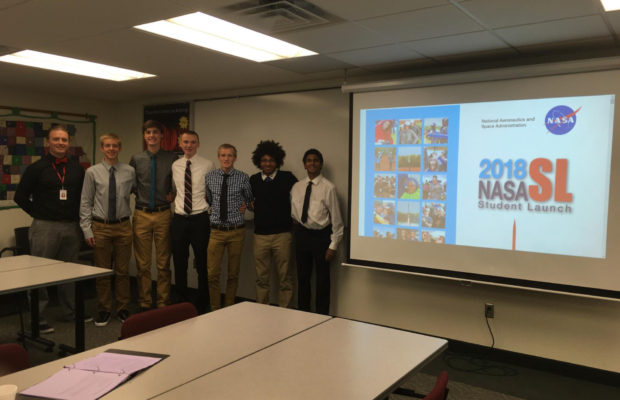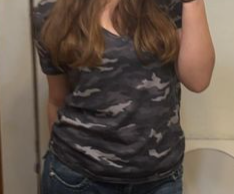Rocket club begins NASA collaboration

Before the sun had risen and cars filled the lot on Oct. 17, five students and one teacher made their way into the darkened hallways of the quiet high school and into room 31 to circle around a small iPhone, all listening intently to the person on the other end.
The rocket club members absorbed all they could from past graduates of NASA about their new design. Information came out of the phone like a firehose, and they could hardly absorb it fast enough.
Following their fifth place finish at the national Team Rocketry America Challenge (TARC), the CFHS S.T.A.R.S. received an opportunity of a lifetime.
The top 25 teams at the competition received an invitation to submit a proposal to NASA for a rocket that they would like to fly and test. “You have to be invited to submit, and to be invited you have to place top 25,” rocket club adviser Zeb Nicholson said.
From there the team created a unique idea — testing the solar intensity of the sun as altitude increases and how that can help fuel the rocket. “We are going to test the intensity of the sun with solar panels on the rocket. A replica of the rocket will be on the ground to measure ground and air,” team leader Will Burken said.
Following the initial idea, the team of six then wrote up a 30-page proposal of their idea and submitted it to NASA. Their anticipation was filling the room as they waited for the response early in October, and within the last five minutes of power hour, the email came in.
“When he opened it (the email), it said ‘Congratulations,’ and we were all yelling and running around. We had sparkling grape juice, and we were bouncing off the walls,” Burken said.
Following the email, the team members were put into a video conference call the next week where they were told information and the different deadlines for their project from NASA. They plan to fly their rocket on April 4 in Huntsville, Ala.
“There are four milestones in the entirety of the project. The proposal is one. The preliminary design review is two, critical design review and flight readiness review,” Burken said.
They have their proposal finished, which moves on to phase two, the preliminary design review. With this the team has to create a sketch and build of the rocket that they will have to send in to NASA for further review in the beginning of November.
“Preliminary design review, so that’s like the first project or first proposal on your rocket idea and your sketch,” materials and design leader Ryan Ritter said.
A crucial part of the team’s success has been a past CFHS graduate from the class of 1980 who has worked at NASA for over 25 years. “He saw our team in the NASA newsletter and contacted us and asked how he could help,” Nicholson said, “He gave us way more information than we thought, which was a good thing.”
Many hours have gone into the project so far, and within the seven month process, there is much more ahead for the team. “We have already put many hours into it and late nights, and we still have a lot to go. This is only the first chunk of a huge project,” Burken said.
With two rocket teams — a brand-new team working on a TARC rocket as well as the NASA team, Nicholson has a lot under his belt. “I am like the football coach making the calls from the sidelines, not playing on the field,” Nicholson said.
The team members know their goal.
“We have to (shoot the rocket) get as close to a mile as possible, and there is awards for most team spirit, but it isn’t really a competition,” Burken said.
With no physical reward ahead for the team, most of the motivation comes from within.“How these guys delegate work is beyond me and what they accomplish. The dynamic is one of the biggest reasons they have been able to be as successful as they are. They know how to get stuff done,” Nicholson said.
Andre Bryan, assistant fundraising and outreach coordinator, agreed with Nicholson’s statement. “We have school going on as well along with rocket club, so it’s kind of like a priority, but it’s not as high on the list, so we still have to budget our time, but we will make it work,” Bryan said.
With determination flowing through their veins, the team is excited to advance through the stages of their rocket, leading to their launch in Alabama on April 4.
With many steps ahead of them the rocket club could use any help they can get with funding. “We have an estimated budget of $6,000-$7,000 for the NASA team alone, which includes all materials and travel,” Nicholson said. “They have room for 60 teams, but in years past, they have never had more than 60 proposals. Due to NASA budget cuts along with more teams attending, they decided to just cut all funding, and we have to do it all on our own.”
Those who wish to help with the funding can contact Nicholson at zeb.nicholson@cfschools.org.
With hard work and great chemistry, the team is bound for success, “When you see a team be so self motivated and just be like ‘hey we got to get this done’. In my head I have an idea of what is happening, but two years ago when we went to nationals it wasn’t that. This team is just so in-tune with each other and so self-driven that is what made them and will make them succeed,” Nicholson said.









You must be logged in to post a comment Login